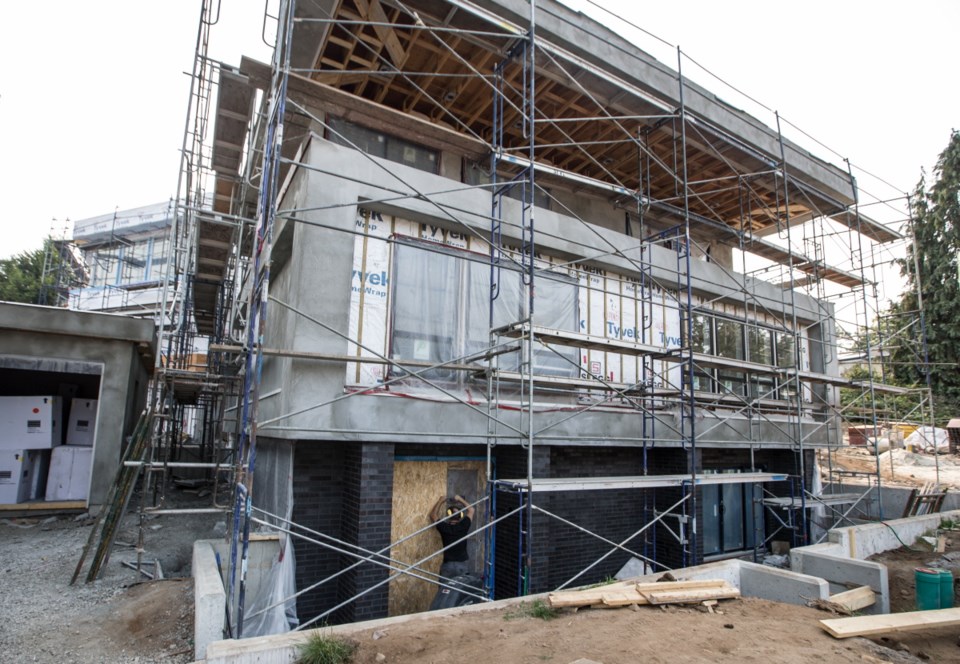A province on fire and the torrid pace of construction on Vancouver Island are driving up the cost of building materials — and there appears to be no price relief in sight, according to industry insiders.
The staples of home construction — lumber and sheeting materials such as plywood and oriented strand board — have increased by 10 and 40 per cent, respectively, and the pace of price changes appears to be increasing.
According to Tim Urquhart, president of Slegg Building Materials, the company has tried to maintain prices for contractors for a minimum of 30 days, but with fires raging and mills closed in British Columbia it’s been difficult to hold the line.
“It’s impossible to go 30 days now, so we have resorted to 15 days because prices are changing that quickly,” Urquhart said. He noted that if prices continue to rise, it could result in a serious slowdown in the building industry.
“We have bought enough wood that’s either on the ground now or coming in that should take us into September, but if these forest fires continue and we don’t get some rain soon, if we don’t get this under control, we will have problems. We won’t have enough wood.”
Pat Millsap, Slegg’s commodity purchaser, said the problem is where the fires are this year — concentrated at the heart of the lumber industry in the southern Cariboo.
“A solid 35 per cent of exportable product comes from the regions affected,” he said.
Millsap said the mills have only had the timber to cut that was on their lot before fire season, as their log supply has since been cut off. “Of the eight large primary [producers] in those regions, six were shut down.”
So far this year, there have been 868 wildfires in the province that have burned nearly 500,000 hectares — 366,000 of those have been in the Cariboo.
Millsap said shutdowns are only part of the problem.
Home-building on both sides of the border has heated up, meaning there is strong demand for the B.C. dimensional lumber used to frame houses.
“The mills had large order files before they were out of production. We went from having three to five weeks lead time [for product delivery] into uncertainty,” he said. “It’s affected how we buy, our inventory position and inbound cost.”
That has resulted in lumber, which Millsap said was already 30 per cent more expensive this year, jumping in price over the past few weeks by another 10 per cent, and sheeting material — which was already in short supply in Canada — increasing by about 40 per cent.
When you factor in the amount of building currently going on around the Island, the idea of being able to build something affordable gets thrown out the window.
Casey Edge, executive director of the Victoria Residential Builders Association, said the increased cost of wood and the increased cost of hiring has meant the cost of building has jumped to $230 per square foot from around $200. A 1,500-square-foot home would now cost about $345,000 to build, not counting the cost of land.
“I’m also hearing, and this hasn’t happened since the boom of 2006, that the trades can walk across the street and get more money. Costs are going up and it’s harder to keep skilled trades, everyone is competing for them,” he said.
It’s already slowing things down, according to veteran builder Ron Bickford.
“You can’t get anything done because it’s so busy,” Bickford said. He can’t find additional workers or skilled trades because “everyone’s working. You can’t find a good body, it’s never been like this before.”
Bickford said the boom is being fuelled by a reasonably strong Island economy, an influx of retirees, down-sizing Vancouverites and other buyers who want to live in the best climate in the country. And he suggested that demand, lack of skilled trades and increasing cost of building materials has helped to drive up the price of land to the point of being “ridiculous.”
Bickford estimated a tear-down home in a decent part of Victoria or Saanich comes with a price tag between $575,000 and $700,000, while the cost of building is now anywhere between $230 and $275 per square foot depending on the finishes.
That means an average 2,500-square-foot home being built now would have a selling price of well over $1 million.
“And there’s no fix until the cycle runs its course,” he said.
For the time being, Slegg, the Island’s largest contractor supplier, is looking for alternatives for its customers.
Urquhart said they have looked at Asian sheeting products, and sheeting board from the drywall industry that would normally be too expensive to be used in residential construction.
“With the price of plywood up 40 per cent, these sheets could be used, though they are normally only used in commercial construction,” he said.
Millsap said builders and suppliers are both walking in new territory.



